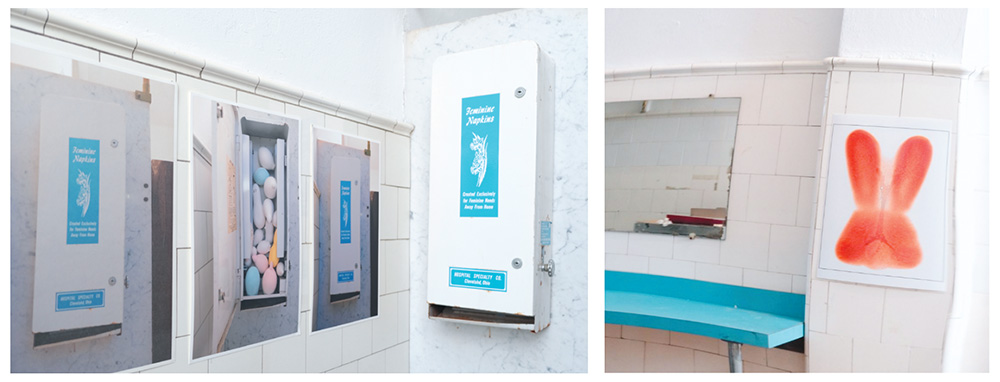Roxy Savage

What happens when a meme is rendered analog and in situ? In two of Roxy Savage’s most recent projects, Pantry/Sampler and THEBATHROOMSHOW, the construct of an analog meme is central. For both projects, Savage employs appropriation, site specificity, and pairs objects with images of themselves. In Pantry/Sampler, wooden shelving, thrift store objects, and Savage’s sculptures hang behind an enlarged sheer organza photo of itself. Through transparency and duplication, reproducibility cohabits in a three-dimensional space. In THEBATHROOMSHOW, which is the focus of this studio visit, Savage explains she is “putting objects in conversations with themselves,” and that conversation is, among other things, conceptual, playful, and feminist.
Savage’s fascination with what was once a fancy executive bathroom in Bridgeport, Connecticut’s American Fabrics Artist Studios (AMFAB), formerly a lace manufacturing plant, was gradual and led to THEBATHROOMSHOW (2024). The installation is an extension of her general curiosity about bathrooms: “For the past five-to-ten years, I’ve taken pictures of bathrooms. I’m intrigued by all the things from different periods and how bathrooms have older features because they are so expensive to replace, but they also get updated, creating an odd mix of old and new.” At AMFAB, a large piece of Mylar that was meant to be a makeshift mirror was one of those oddball updates, leading Savage to hang photos in the bathroom: “It was a self-portrait of me in a piece of Mylar, during COVID that got me started. I, like everyone, was so confused and out of sorts and the reflection was super distorted. I hung the print up in the bathroom and then started adding pictures here and there.”
Yet it was a defunct tampon dispenser that really got her thinking about a site-specific exhibition. “It reminded me of the 1960s. I imagined a woman needing a tampon, putting a coin in, and turning this metal knob. One of the maintenance people said, ‘we should take it down,’ but I wanted it to stay. So I made a sign that said ‘This is Feminist History’ and put it on the box.” As part of the installation, she inserted sculptures into the empty box (including existing plaster forms she made using variously inflated balloons as molds) and photographed it open and closed. Savage then hung the digital prints nearby. “I see the tampon box in part as kitsch feminist hygiene history,” says Savage. “I loved repurposing it with unrelated objects that resemble breasts.”

Savage’s practice often incorporates past works or variations on them, and in THEBATHROOMSHOW, a handful of digital prints uses existing work as source material. In one, Savage placed a tomato-red, minimalist resin bunny head made from a domestic kitchen mold on a lightbox and photographed it. The resulting 13 x 19 inch image resembles a stain or a colorful MRI scan, inviting viewers to consider the bodies that have used the facilities. Another print features a ghostly red silhouette of the U.S.—a lightbox photo of a bioplastic gelatin map she made with a cake mold. By placing these prints in conversation, Savage prompts viewers to contemplate the Savagepublic/private realms bodies traverse and the patriarchal political systems that often police them.
In addition to the tampon box images, the bathroom’s hand dryers and toilet paper holders are replicated in a series of black-and-white photos that highlight their repeated forms and gridded tile backdrops. By zooming in, duplicating, and reframing the familiar, Savage’s approach, which she describes as “reinforming,” is in conversation with 1970s conceptual art practices and the embodied qualities of second-wave feminist art. By reinforming the mundane, Savage transforms the bathroom into a provocative site for contemplating bodily functions (menstruation, urinating, defecating), architecture (Greek-style tiles alongside a slop sink, etc.), contemporary debates about gender, feminist art histories, and more.
Judy Chicago and Miriam Schapiro’s feminist exhibition Womanhouse (1972)—where CalArt students installed art installations centering the female experience—is one of those historic influences. “Much of my work revolves around the home and domestic labor; and I’m realizing that the menstruation room at Womanhouse, where used tampons were in the bathroom’s trash cans, is very important to me because it exposed what women were really dealing with. Subliminally, I’m sure it informed THEBATHROOMSHOW.” Two other recurring tropes in Savage’s work also animate this exhibition: a suggestion box and a table of toilet paper rolls visitors can use to make sculptures add interactivity; and, while serious themes like bodily autonomy undergird the show, the tone is also humorous. For Savage, humor is, in part, a strategy for inclusion: “The seriousness that people put on art is a little ridiculous. By putting art in the bathroom, you are sort of immediately deflating that kind of elitism. So, humor is a really big part of what I do. It’s like, why can’t we just have some fun, here?”
